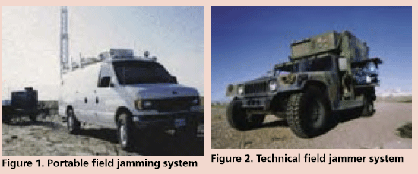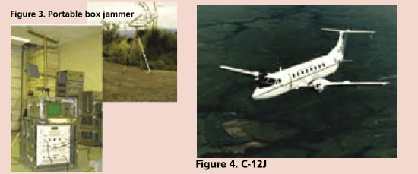| GNSS | |
JAMFEST, A cost effective solution to GPS vulnerability testing
|
||||
|
The 746th Test Squadron (746 TS) has conducted complex GPS jamming experiments since the early 1990s and played a key role “behind the scenes” creating multiple high-profile jamming environments for programs such as the Joint GPS Combat Effectiveness (JGPSCE) exercises and Quick Reaction Tests. These programs, conducted to support real-world operations, enhanced the 746th TS’s ability to recreate realistic jamming environments and resulted in the 746 TS earning the reputation as the recognized experts for open-air GPS vulnerability testing. The 746 TS conducted JAMFEST as an opportunity to broaden both the operational and test communities’ awareness of GPS vulnerabilities by offering a cost-effective, operationally realistic venue to facilitate testing and training objectives. This opportunity was truly important to the operational and test communities because GPS signals use very low power and are vulnerable to both intentional and unintentional interference. These effects can adversely impact the position and timing accuracy of various receivers and navigation devices employed by military and civilian users. Because of this adverse impact, it was critical to the success of the program that the jamming environment be both operationally realistic and beneficial to the military and civilian users. Specifically, it involved coordinating frequency clearances, securing range space, developing jamming scenarios, deploying personnel and equipment, operating the threat assets, data reduction and analysis, reporting, and securing funding for the program. By capitalizing upon their unparalleled experience base, the 746 TS easily met and overcame these tasks. The 746 TS designed innovative vulnerability scenarios that streamlined test conduct into a one-week event that maximized set-up efficiency and significantly reduced costs to the participants. This was the first in a series of recurring events. Objectives/ResourcesThe overall objective of JAMFEST was to provide and characterize the GPS jamming environment in multiple configurations to enable the participants to test, train, or gain experience in a GPS jammed scenario. Each participant used JAMFEST to execute their own objectives, which included the following: • Evaluate the effects of jamming on a representative set of GPS receivers to determine the effective range from the jammers and the power level that disrupts GPS tracking; • Evaluate potential benefits of anti-jam technology available to civil operators; • Collect performance data against specific targets/environments that will confirm proper operation of the overall locator system and sub-system; • Subject anti-jam systems under test to high GPS jamming/Signal (J/S) environments and compare results; • Collect jamming environment truth data to improve and verify laboratory modeling and simulation tools, vulnerability prediction analysis, and mission planning software; • Validate tactics, techniques and procedures (TTPs) using hand held receivers (HHRs). To effectively execute these objectives, the 746 TS employed multiple test assets to configure an operationally representative GPS jamming environment. The ground jamming configuration was set up on White Sands Missile Range (WSMR). One of the primary test resources used to create the jamming environment was the Portable Field Jamming System (PFJS). The PFJS (see Figure 1) is a modified Ford 350 van with a full suite of GPS Electronic Warfare (EW) equipment, which included TMC Advanced Threat Emulators (TATEs) and TAVIA-32 Emulators (TAVIAs) as well as a variety of high power adjustable amplifiers. The onboard EW equipment was programmed to provide a wide range of jamming scenarios and signal modulations. The system records time-tagged amplifier power output for test analysis and time correlation to the test item. Another key resource employed was the Tactical Field Jamming System (TFJS). The TFJS (see Figure 2) is designed to supply the same capabilities as the PFJS, but in a vehicle capable of accessing terrain that is more rugged. Each TFJS is a modified High Mobility Multi-Purpose Wheeled Vehicle (HMMWV) that comes equipped with a full suite of GPS EW equipment, which includes TATEs and TAVIAs, as well as a variety of high power adjustable amplifiers. Due to the TFJS’s ability to be positioned in areas inaccessible to most vehicles, these jammers were set up in remote territory and controlled via radio modem. Portable Box Jammers (PBJ) (see Figure 3) in conjunction with the PFJSs and TFJSs, were set up along designated range roads and remote locations to help create the jamming environment. Each PBJ is a stand-alone jamming system designed to supply the same capabilities as the PFJS and TFJS, but in a smaller, more versatile package. Each system was equipped with portable generators, a portable antenna mast and tower, and a full suite of GPS EW equipment that included TATEs and TAVIAs, as well as a variety of high power adjustable amplifiers. The 586th Flight Test Squadron (586 FLTS), a sister squadron to the 746th TS, characterized the jamming field using the C-12J (see Figure 4). The C-12J is a Beechcraft 1900 twin turbo-prop aircraft that has been modified to for GPS/inertial guidance and navigation components and systems tests. Its capacities include a 16,600-pound maximum gross weight and a maximum of four test stations or equipment pallets. The aircraft was configured with controlled reception pattern antenna (CRPA) ports and fixed reception pattern antenna (FRPA) ports on the top and bottom of the fuselage. During JAMFEST, the C-12J carried 746 TS equipment designed to collect airborne reference measurements of the GPS jamming environment. It flew data collection sorties that spanned the airspace and altitudes used by the systems under test. In any test environment where navigation aids are evaluated, it is paramount that the truth reference data is preserved and collected. This is particularly difficult to achieve in a live GPS jamming environment, because many reference systems use GPS to obtain an accurate truth source. To overcome this obstacle, the 746 TS developed the CIGTF Reference System (CRS); this was the reference system used for JAMFEST. The CRS is a rack-mounted (see Figure 5), loosely/tightly-integrated system, consisting of navigation sensors/subsystems, Data Acquisition System (DAS), and post-mission processing mechanization (see Figure 6). The DAS, a DOS-based computer, performs the primary functions of data collection and real-time control for the following subsystems: (1) Embedded Global Positioning System (GPS)/Inertial Navigation System (INS) (EGI) navigation system, (2) GPS receiver/receivers, (3) Standard Navigation Unit (SNU) INS, and (4) Cubic CR-100 Range/Range Rate Interrogator/Transponders System (RRS). Other subsystems supported in the CRS architecture are the GPS Environment Monitoring System (GEMS), data link, altitude encoder, and Satellite Reference Station (SRS) receiver supporting differential GPS (DGPS) algorithms. The post-mission processing mechanization utilizes combinations of the subsystem measurements in an extended Kalman filter/smoother algorithm to produce an optimal reference trajectory. Nominal performance accuracies of the reference trajectory characterized for JAMFEST are detailed in Figure 7. |
Pages: 1 2














 (No Ratings Yet)
(No Ratings Yet)




